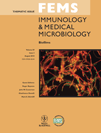Effect of simulated microgravity on growth and production of exopolymeric substances of Micrococcus luteus space and earth isolates
Editor: GianFranco Donelli
Abstract
Microorganisms tend to form biofilms on surfaces, thereby causing deterioration of the underlaying material. In addition, biofilm is a potential health risk to humans. Therefore, microorganism growth is not only an issue on Earth but also in manned space habitats like the International Space Station (ISS). The aim of the study was to identify physiological processes relevant for Micrococcus luteus attachment under microgravity conditions. The results demonstrate that simulated microgravity influences physiological processes which trigger bacterial attachment and biofilm formation. The ISS strains produced larger amounts of exopolymeric substances (EPS) compared with a reference strain from Earth. In contrast, M. luteus strains were growing faster, and Earth as well as ISS isolates produced a higher yield of biomass under microgravity conditions than under normal gravity. Furthermore, microgravity caused a reduction of the colloidal EPS production of ISS isolates in comparison with normal gravity, which probably influences biofilm thickness and stability as well.




